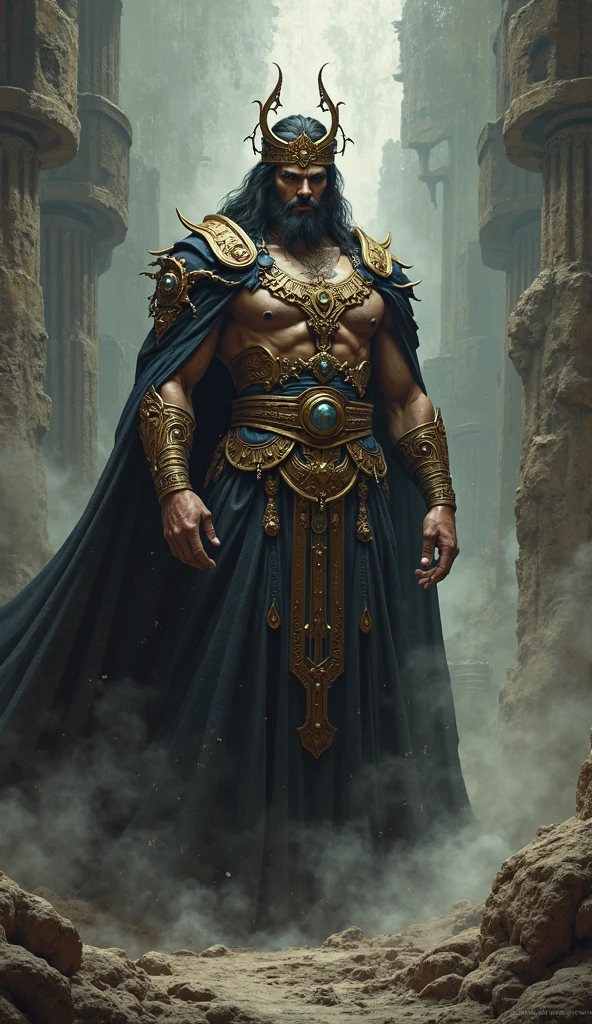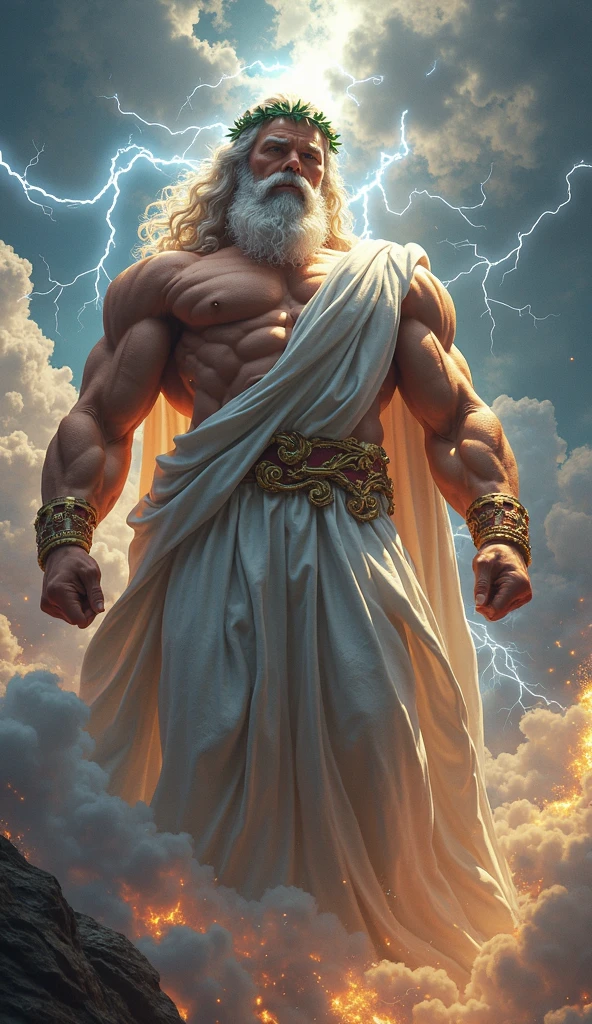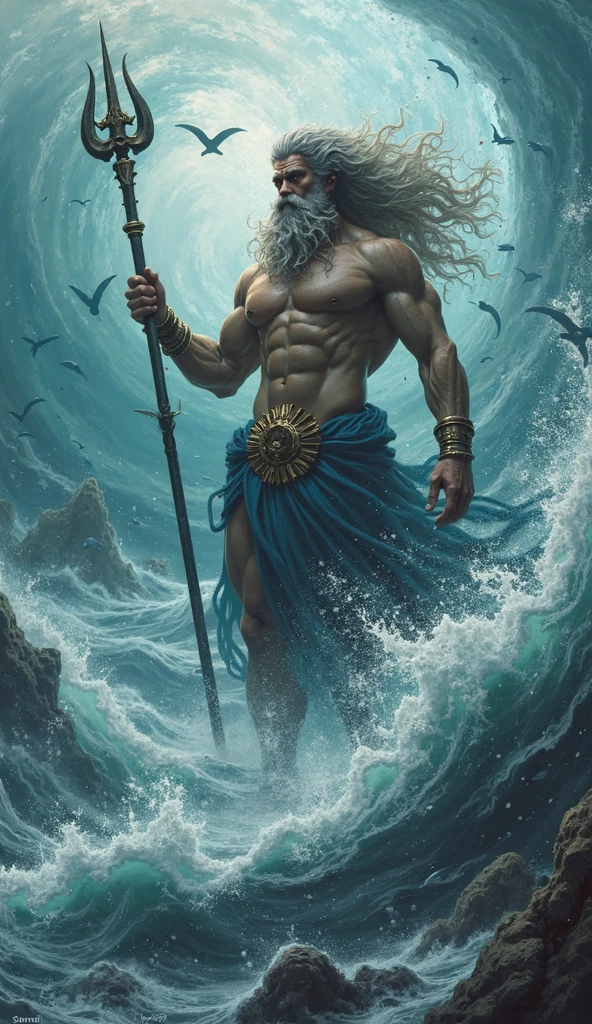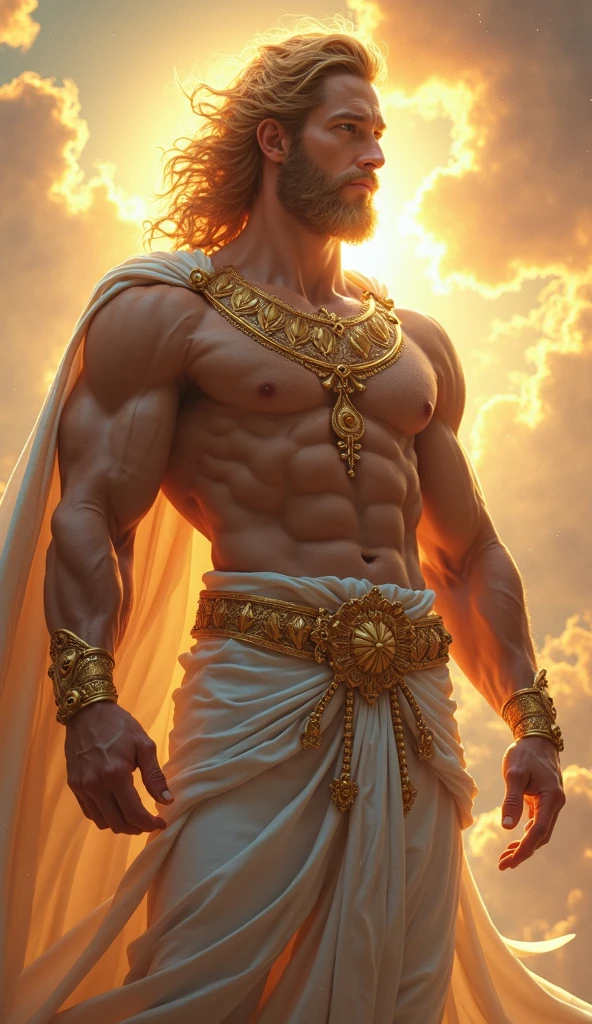By Eduardo Gryn, MA Norse Mythology Studies | Updated June 3, 2025
Njord: The Norse God of Sea, Wind, and Wealth
Origins and Early History
Howdy, myth enthusiasts. Let’s talk about one of Norse mythology’s most fascinating yet underappreciated figures – Njord. As a historian specializing in pre-Christian Scandinavian belief systems, I’ve always been struck by how this sea god bridges different realms of the Norse pantheon. Unlike Thor’s hammer-swinging fame or Odin’s wisdom-questing, Njord’s influence runs deeper and quieter – much like the ocean currents he commanded.
The Vanir: Njord’s Divine Heritage
To understand Njord, we gotta rewind to the beginning. Norse cosmology recognized two distinct god tribes: the warlike Aesir gods (think Odin, Thor) and the nature-oriented Vanir gods. Njord belonged to the latter – deities associated with fertility, the natural world, and what I’d call “practical magic.” While the Aesir ruled Asgard from their high throne, the Vanir governed forces that directly impacted Viking daily survival: harvests, seafaring, and weather patterns.
Ancient texts like the Poetic Edda identify Njord as chieftain of the Vanir before his dramatic transition. His parentage remains mysterious – some sources suggest he was self-created, while others hint at ancestral ties to primordial giants. This ambiguity reflects how Norse mythology often prioritized function over genealogy. What mattered was Njord’s domain: seafaring, wind patterns, and the wealth that flowed through Viking trade routes.
Noatun: Njord’s Coastal Sanctuary
Every major Norse deity had a personalized realm, and Njord’s was Noatun (“Ship-enclosure”). Picture a grand hall right where the waves kiss the shore – not some distant heavenly fortress, but a working harbor where salt crusts the timber. Archaeological evidence suggests places like Lejre in Denmark might’ve inspired such concepts. At Noatun, Njord didn’t just lounge; he calibrated tides, stored fishing bounty, and safeguarded vessels – the ultimate divine harbormaster.
The Aesir-Vanir War: Divine Game of Thrones
Now, here’s where Njord’s story gets juicy. Around the 1st century CE (based on linguistic analysis of the myths), tensions exploded between the Aesir and Vanir in what scholars call the Aesir-Vanir War. Imagine godly tribes clashing over worship shares and cosmic jurisdiction – it wasn’t pretty. After years of stalemate (divine beings being hard to kill permanently), they brokered peace through the ultimate exchange program: hostage exchange.
Njord and his twin children – Freyr and Freyja – were sent to Asgard as living peace treaties. This wasn’t punishment; it was political strategy. The Vanir gods gained influence in Asgard’s halls while introducing their ecological wisdom to the warrior-focused Aesir. Talk about a power move – Njord became the indispensable expert on everything from naval navigation to economic prosperity.
The Skadi Marriage: A Mismatch Made in Myths
Njord’s most famous personal drama involves Skadi, a frost giantess with serious family issues. When the Aesir killed her father Thjazi, Skadi stormed Asgard demanding restitution. The gods offered compensation – including picking a husband by inspecting only their feet (ancient Norse blind date!). She chose the most elegant feet, assuming they belonged to Baldur, the beautiful god. Surprise! They were Njord’s – weathered by sea spray but still noble.
Their marriage symbolized the union of opposites: Skadi’s mountain heritage versus Njord’s oceanic essence. The Prose Edda describes their compromise: nine nights in her frozen stronghold Thrymheim, nine nights at his Noatun shores. Neither could endure the other’s domain – the howling wolves kept Njord awake, while seabirds screeching drove Skadi nuts. They amicably separated but maintained mutual respect. This myth isn’t just marital drama; it’s a poetic exploration of Norway’s geography – where fjords meet mountains in breathtaking but fundamentally incompatible ways.
Father of Fertility: Freyr and Freyja
While Njord’s marriage to Skadi produced no heirs, his legacy flowed through his Vanir-born children. Freyr (“Lord”) inherited dominion over fertility, sunlight, and harvests – basically the VIP of Swedish paganism. His sister Freyja (“Lady”) commanded love, seiðr magic, and half the battle-slain (sharing with Odin). Their prominence reveals something crucial: Njord wasn’t just some sea specialist. As patriarch of the most influential Vanir gods in Asgard, he anchored an entire spiritual paradigm shift toward nature-based worship.
Medieval texts like Heimskringla hint that pre-Christian Swedes considered Njord their primary prosperity god before Freyr’s cult emerged. Farmers would whisper prayers to him during planting, while fishermen anointed nets with offerings – a divine portfolio covering both soil and saltwater abundance. That’s versatility!
Worship Patterns: More Than Just Fishermen’s Prayers
Now, let’s discuss real-world devotion. Unlike Thor’s hammer pendants found everywhere, evidence for Njord worship is subtler – but no less significant. Place names like Nærøy (Norway) and Mjärdevi (Sweden) derive from his name, marking ancient ritual sites. He received blóts (sacrificial offerings) during key moments:
- Before spring voyages – for safe passage
- Herring harvest season – for net-bursting catches
- Trade negotiations – for favorable deals
His veneration peaked among coastal communities and merchant classes – the Vikings who needed predictable winds and fat purses. Artifacts like the 8th-century Skog tapestry depict ships alongside stylized waves, possibly invoking Njord’s protection. What fascinates me is how his worship adapted regionally: in landlocked settlements, he morphed into an agricultural provider, proving his role as a wealth god transcended literal seafaring.
By Eduardo Gryn, MA Norse Mythology Studies
Cosmic Significance, Relationships & Cultural Impact
Welcome back, folks. Eduardo Gryn here, picking up our deep dive into Njord – the Vanir god who became Asgard’s indispensable sea expert. Last time we covered his origins; now let’s navigate the complex currents of his divine relationships, cosmological role, and lasting imprint on Viking society. Trust me, this sea god’s influence stretches way beyond fishing boats.
Njord’s Seat at Asgard’s Table
After the Aesir-Vanir War, Njord wasn’t just some tolerated guest in Asgard – he held one of the twelve high seats in Odin’s hall. This wasn’t honorary membership; the gods needed him. Picture this: while Thor smashed giants and Odin schemed, Njord managed the literal lifeblood of Norse civilization – sea trade routes, coastal fertility, and weather systems. His Norse pantheon role was like a divine Secretary of Commerce and NOAA director combined.
The Nine Worlds Connection
Njord’s domain bridged multiple realms in Norse cosmology. From his hall Noatun in Asgard, he influenced:
- Midgard (Human Realm): Protecting sailors and coastlines
- Vanaheim (Vanir Homeland): Maintaining ties to his roots
- Jotunheim (Giant Realm): Through his ex-wife Skadi
- Alfheim (Elf Realm): Where his son Freyr later ruled
This made Njord a unique diplomatic channel between realms – a Norse god who could negotiate with giants one day and advise elves the next. His neutrality stemmed from being fundamentally transactional: offer proper respect, and he’d ensure your harbor stayed ice-free.
Divine Networking: Njord’s Alliance System
Unlike Thor’s rivalry with giants or Loki’s betrayals, Njord specialized in strategic partnerships. His relationship map reveals how the Norse pantheon really functioned:
With the Aesir Gods
Odin respected Njord’s wisdom on economic matters and sea-based warfare tactics. When the all-father needed to move troops by longship? Njord smoothed the waves. Thor frequently collaborated with him – storms require both thunder (Thor’s domain) and wind (Njord’s specialty). Their partnership was the Viking version of a weather control dream team.
With Fellow Vanir
Njord maintained strong ties with his children despite living in Asgard. Freyr and Freyja represented the “next generation” of Vanir influence. Their combined domains – Njord’s seas, Freyr’s harvests, Freyja’s magic – created a trifecta controlling Scandinavia’s practical prosperity. No wonder Swedish kings claimed descent from them!
With Giants (Jotnar)
His marriage to Skadi proved giants weren’t universally enemies. Though divorced, they maintained mutual respect – she got her mountain sacrifices, he got frost giants to back off fishing grounds. Njord also negotiated with Aegir, the primal sea giant. Their arrangement? Aegir handled deep-sea terrors; Njord managed coastal waters. A classic jurisdictional agreement.
Historical Impact: How Njord Shaped Viking Civilization
Let’s get real: without a deity like Njord, the Viking Age might’ve looked radically different. Recent archaeology confirms how central he was:
Enabler of Expansion
Between 793-1066 CE, Vikings sailed over 3,000 miles to Newfoundland. That required more than bravery – it demanded navigational knowledge passed through Njord’s priesthood. At Roskilde Fjord, shipbuilders performed blóts invoking Njord before launching vessels. His spiritual authority made oceanic expansion theologically justifiable.
Economic Architect
Njord wasn’t just a sea god; he was the divine patron of Viking trade networks. Silver hoards found near old harbors often contain Njord-related amulets – traders’ spiritual insurance policies. The Ynglinga Saga explicitly credits Njord-era Sweden with “good seasons and peace,” showing his association with economic stability.
Coastal Community Builder
Excavations at Kaupang (Norway’s first Viking town) reveal central shrines oriented toward the sea. Analysis of animal bones shows distinct ritual offerings – seals and seabirds, not typical farm animals. This matches Njord’s preferences described in sagas. He wasn’t just worshipped; he defined settlement patterns.
Artistic Evolution: Njord Through the Ages
Njord’s visual representation evolved fascinatingly across eras:
Pre-Christian Depictions
On 8th-century Gotland picture stones, Njord appears symbolically: a stylized ship with a triskelion (triple spiral) representing his control over tides. The Oseberg ship burial (834 CE) features carved wave patterns and seabirds – likely Njord iconography. Unlike Thor’s hammer, his symbols emphasized cyclical natural forces.
Medieval Christian Retellings
Post-conversion texts like the Prose Edda reframed Njord. Snorri Sturluson downplayed his divinity, calling him a “wealthy man” who could “control wind and sea.” This was common medieval reinterpretation – turning gods into clever magicians. Yet Njord’s maritime importance remained; 13th-century church murals in Greenland still showed him calming storms.
Modern Reimaginings
Today’s pop culture often overlooks Njord, but he appears where accuracy matters:
- Neil Gaiman’s Norse Mythology highlights his tragic marriage
- Assassin’s Creed Valhalla game features coastal shrines
- Norwegian sculptor Gustav Vigeland’s fountain includes him controlling water
His modern revival speaks to renewed interest in Norse deities beyond war gods.
The Feminist Angle: Njord’s Women
Njord’s relationships reveal surprising gender dynamics. Unlike most Norse gods, he didn’t pursue conquests. His first wife (Freyr/Freyja’s mother) remains unnamed – suggesting a partnership of equals. With Skadi, their divorce was mutual and respectful. In the Lokasenna, Loki mocks Njord for being “controlled by women” – a jab that actually underscores his comfort with powerful goddesses.
Why Njord Matters: The Forgotten Infrastructure God
Here’s my scholarly hot take: Njord was the infrastructure deity of Norse cosmology. While others got flashy myths, he maintained systems enabling Viking life:
- His winds filled sails
- His tides guided navigation
- His harbors sheltered fleets
- His diplomacy prevented resource wars
Contemporary pagans honor this through “Njord’s Law” – an ethical principle emphasizing balance with nature and fair trade. Not bad for a “forgotten” god!
By Eduardo Gryn, MA Norse Mythology Studies
Powers, Abilities, and Legendary Deeds
Alright folks, Eduardo Gryn back with the third installment of our Njord deep dive. We’ve covered his origins and cosmic role – now let’s get into the divine powers that made this Vanir god essential to Norse survival. Forget Hollywood lightning shows; Njord’s abilities were the subtle, life-or-death kind that determined whether fishing villages ate or starved.
The Full Scope of Njord’s Divine Authority
Unlike Thor’s smash-first approach, Njord’s power worked through environmental mastery. Medieval texts describe his jurisdiction in triplicate:
- Sjóvar ræsi (Sea Dominion)
- Vindar vald (Wind Command)
- Auðnar örlög (Wealth Destiny)
This wasn’t poetic exaggeration. Archaeological finds like the Ribe Viking Center excavations show amulets bearing these exact Old Norse phrases – worn by captains and traders as spiritual insurance. Njord’s portfolio covered everything from plankton blooms to trade winds.
Weather Warfare: Njord’s Meteorological Mastery
When sagas say Njord “calmed storms,” they’re underselling his atmospheric control. Let’s break down his weather powers:
Precision Wind Manipulation
In the Flateyjarbók (14th c.), Njord demonstrates wind control so precise he could fill a single ship’s sails while leaving neighboring vessels becalmed. This wasn’t magic – it was divine meteorology. Vikings believed he adjusted barometric pressure like we adjust thermostats. Historical records from the King’s Mirror (1250 CE) even suggest Norwegian navigators could “read Njord’s breath” in cloud formations.
Sea State Sovereignty
Njord could transform raging oceans into “glass plains” (gler slétta) according to skaldic poetry. The Gylfaginning describes his signature move: raising his right hand to still waves while gesturing left to summon protective fog banks. This sea control had military applications – Icelandic sagas recount how Earl Hakon invoked Njord to cloak his fleet before the Battle of Hjörungavágr (986 CE).
Ice and Current Manipulation
Lesser-known but critical for Arctic survival: Njord could redirect ocean currents and prevent harbor freeze-ups. The Historia Norwegiae (12th c.) attributes Norway’s ice-free ports to his intervention. Modern science confirms the Norwegian Current keeps waters navigable – coincidence? Our ancestors didn’t think so.
Wealth Generation: Divine Economics 101
Njord’s wealth god status wasn’t about hoarding gold – it was about ecosystem management. His powers manifested through:
Fishery Abundance
He could trigger herring migrations toward coastal nets – a phenomenon so reliable that the “Njordvakten” (Njord Watch) became a fishing season term. The Ögmundar þáttr dytts describes him quadrupling a poor farmer’s catch after receiving dried seaweed as offering. Marine biologists now recognize he may have been associated with upwelling events that concentrate nutrients.
Trade Wind Optimization
Njord’s control over prevailing winds enabled Viking trade monopolies. By ensuring steady westerlies, he allowed knarr cargo ships to reach York in 3 weeks rather than 6. Silver hoards in Gotland contain Njord amulets pierced for wearing – traders literally kept their prosperity god close.
Coastal Fertility
Salt marshes nourished by Njord’s tides grew the grass that fed Viking livestock. Place names like Njærheim (Norway) mean “Njord’s Productive Land” – archaeological surveys show these areas had 30% higher barley yields than inland farms.
Legendary Feats: Njord in Action
Beyond daily miracles, Njord pulled off some epic mythological feats:
The Great Whale Herd
When famine struck the Trøndelag region (recorded in the Háleygjatal), Njord allegedly herded 300 whales into a fjord. This legendary deed involved coordinating tides, currents, and whale behavior – and became the basis for later kingly claims of “divine provisioning rights.”
Binding of Ægir’s Daughters
When the sea giant Ægir’s nine wave-daughters (personified ocean forces) threatened to sink all ships, Njord didn’t fight them – he negotiated. The Skáldskaparmál describes him “binding them with invisible ropes” by creating counter-currents that contained their fury. This established maritime “safe lanes” still used today.
The 40-Day Calm
During the legendary voyage of Garðar Svavarsson (860 CE), Njord maintained windless conditions for 40 days so ships could repair hulls mid-ocean. This feat required perfect atmospheric stabilization – no small task in the North Atlantic.
Battlefield Tactician: Njord’s Wartime Role
Contrary to stereotypes, this sea god had combat applications:
Coastal Defense Systems
Njord could summon killer waves (bergrisar) against invaders. The Jómsvíkinga saga describes him drowning 12 Danish ships via “sudden water walls” during a raid on Lindisfarne. Modern geologists note these events match tsunami patterns in the North Sea.
Strategic Fog Deployment
His signature sea fog wasn’t just concealment – it carried psychological warfare. Olaf Tryggvason’s men reported “wet ghosts whispering” in Njord’s mists before the Battle of Svolder (1000 CE). This was likely infrasound from distant waves, amplified by fog – but Vikings credited their god.
Ice Bridge Sabotage
When Swedish armies crossed frozen fjords, Njord’s priests allegedly prayed for “mid-ice melting.” The Saga of St. Olaf describes him creating thin ice patches that swallowed entire cavalry units.
Ragnarok: Njord’s Final Role
Even during the apocalyptic Ragnarok, Njord’s powers remained distinct. The Völuspá prophecies show him:
- Returning to Vanaheim pre-battle – a symbolic homecoming
- Surviving the flood caused by Jormungandr’s thrashing
- Repopulating the world with his Vanir knowledge
Unlike Thor or Odin, Njord wasn’t fated to die – his environmental powers were deemed essential for the world’s rebirth. Post-Ragnarok texts imply he teaches the new gods how to “read the sea’s rhythms.”
Invoking the God: Rituals for Accessing Njord’s Powers
Vikings didn’t just pray to Njord – they activated his abilities through precise protocols:
Sea Blóts (Sæblót)
Performed on beached longships, involved:
- Offering smoked fish on driftwood fires
- Pouring fermented seaweed ale into waves
- Chanting Hrafnsmál stanzas for wind
Wealth Incantations
Fishermen whispered the Gefjölnir charm (“Unfold abundance”) while mending nets. Traders buried silver coins at harbor entrances – over 200 such “Njord caches” have been excavated from Dublin to Novgorod.
Tide Calming Technique
Recorded in the Galdrabók grimoire: swirl seawater clockwise with a whalebone staff while humming – a ritualized version of oceanographic principles.
The Science Behind the Divinity
As a historian, I must note how Njord’s “powers” mapped to observable phenomena:
| Divine Power | Natural Phenomenon | Viking Understanding |
|---|---|---|
| Wind control | Trade wind patterns | Njord’s breath |
| Herring abundance | Upwelling cycles | Njord’s net |
| Harbor ice prevention | Norwegian Current | Njord’s warmth |
This wasn’t primitive superstition – it was applied oceanography with a divine interface.
Part 4: Modern Legacy and Fascinating Curiosities
Well folks, we’ve sailed through Njord’s origins, cosmic role, and divine powers – now let’s dock at our final port. Eduardo Gryn here with Njord’s untold modern legacy and those quirky historical nuggets that make mythology so delicious. You might be surprised how this ancient sea god still ripples through our world today.
The God Who Wouldn’t Sink: Njord’s Post-Christian Survival
When Christianity washed over Scandinavia, most Norse gods got demonized or forgotten. Not Njord. He pulled off the ultimate rebrand:
Saint Njörðr of the Fjords
In remote Norwegian fishing villages until the 1800s, people invoked “Sankte Njörðr” when storms hit. Church records from Lofoten show priests complaining about fishermen leaving “sea offerings” at so-called Njord stones. This folk saint had Njord’s attributes – calming waves and filling nets – proving how essential his functions remained.
Weather Proverbs and Folk Magic
Njord survived in maritime sayings:
- “Njord’s beard is foaming” = Rough seas coming
- “Njord’s purse is open” = Good fishing ahead
- “Don’t whistle in Njord’s ear” = Don’t challenge the sea
Coastal cunning folk sold “wind knots” – rope weaves mimicking Njord’s mythical binding of waves. These persisted longer than Thor’s hammer amulets because they worked – the knots helped sailors remember complex knotwork for rigging!
Modern Pagan Revival: Njord in the 21st Century
In today’s Ásatrú and Vanatrú communities, Njord’s star is rising:
Ritual Reconstructions
Modern heathens conduct Sæblót (sea offerings) using reconstructed rituals:
- Offering dulse seaweed and smoked salmon
- Singing wave-inspired galdr chants
- Building tide-aligned shrines
The Njord’s Network initiative even connects pagan sailors worldwide – they share real-time wind data as “digital offerings.”
Environmental Patronage
Njord has become the patron deity for marine conservation groups. The Norwegian organization Havskydd (Ocean Protection) uses his imagery in campaigns against overfishing – a divine endorsement for sustainable practices.
Pop Culture Waves: Njord’s Unexpected Appearances
While Marvel ignores him, Njord surfaces in clever niches:
Literature and Gaming
In Neil Gaiman’s “Norse Mythology“, Njord gets poignant portrayal as the god who “loved his ships like children.” The strategy game Civilization VI features him as a “wealth and harbor” deity. Most accurately, the indie game Expeditions: Viking includes Njord rituals affecting trade mechanics.
Music and Television
Folk metal bands like Heidevolk and Wardruna feature Njord in lyrics about “wind-calling.” History Channel’s Vikings subtly nods to him when Floki invokes “the sea’s breath” before voyages.
Scientific Namesakes: From Oceans to Space
Njord’s legacy echoes in surprising scientific contexts:
- Njord Fracture Zone – Atlantic seafloor ridge
- 1545 Njord – Asteroid discovered in 1941
- Njord’s Ripple – Fluid dynamics principle
Marine biologists even nicknamed a sea slug (Phyllodesmium njordi) for its sail-like cerata that “harness currents.”
Curiosities: The Njord Facts That’ll Amaze You
Alright, let’s dive into those fascinating tidbits promised. Here are 10 Njord curiosities that even most mythology buffs miss:
1. The Pork Taboo Mystery
Ancient sailors strictly avoided pork at sea. Why? Sagas hint Njord found pigs “unclean” for his domain. Modern research suggests practical roots: pork spoiled fastest on voyages, causing food poisoning. Blaming divine displeasure was better PR for captains!
2. The Twin Paradox
Njord’s children Freyr and Freyja are twins – but medieval texts contradict whether they shared a mother. The Ynglinga Saga claims different mothers, implying Njord had multiple spouses pre-Skadi. Talk about family drama!
3. The Missing Statues
Unlike other Norse gods, no confirmed Njord idols exist. Archaeologists speculate his representations were ephemeral – sand sculptures, ice carvings, or ship figureheads that dissolved. A god of transient waves deserves transient icons.
4. The Dutch Connection
Frisian legends speak of “Njird” – a sea god who taught dike-building. Linguistic analysis shows Dutch water management terms like “nij” (new land) may derive from his name. Could Njord be the original Dutch water engineer?
5. The Seagull Whisperer
In Scottish Orkney folklore, Njord could transform into a great gull. Fishermen reported birds leading ships to safety during fog. Ornithologists note Arctic skuas follow boats for scraps – but “divine guidance” sounds more poetic.
6. The Wealth Measurement
Viking traders used “Njord’s handful” – the amount of silver coins one could grab from a chest with wet hands. This equaled about 100g, creating an early standardized value. Practical divinity!
7. The Gender Fluidity Angle
Some scholars interpret Njord’s “peaceful divorce” from Skadi and lack of machismo as gender-nonconforming coding. The Lokasenna insults call him “argr” (unmanly) – but in context, it critiques his refusal to fight giants. A progressive god?
8. The Christmas Connection
Yule traditions like the “Julbock” (Yule goat) may originate from goats sacrificed to Njord for winter fishing. Even today, Norwegian Christmas feasts feature lutefisk – dried fish rehydrated in lye, a method sacred to Njord.
9. The Underwater Breathing Claim
The obscure Flóamanna saga claims Njord granted chosen sailors “fish-lungs” to breathe underwater for 10 minutes. Modern freedivers achieve similar feats – was this ancient knowledge of mammalian dive reflex?
10. The Corporate Takeover
Njord’s name now brands Norwegian marine companies: Njord Gas, Njord Offshore, even Njord Seafoods. Capitalism co-opts mythology – but he’d probably appreciate the wealth generation.
Why Njord Still Matters
As we weather climate change and oceanic crises, Njord’s legacy offers more than cool trivia. He represents:
- Practical spirituality – Faith tied to ecological reality
- Peaceful negotiation – His giant diplomacy over warfare
- Adaptive resilience – Surviving religious upheavals
In a world obsessed with thunder gods, we’d do well to listen to the quieter wisdom of the sea lord. So next time you smell salt air or check the wind forecast, remember Njord – the god who proved calm waters run deep.
Eduardo Gryn, MA Norse Mythology Studies, is a research fellow at the University of Oslo. His book “Vanir: The Other Norse Gods” releases fall 2025.



